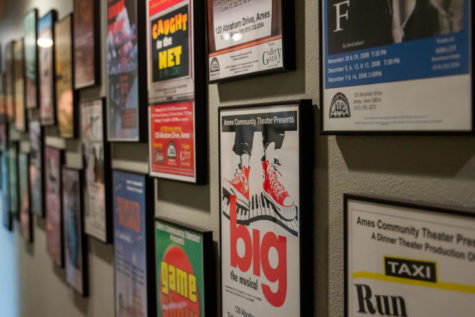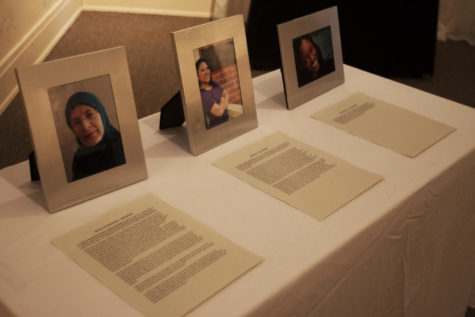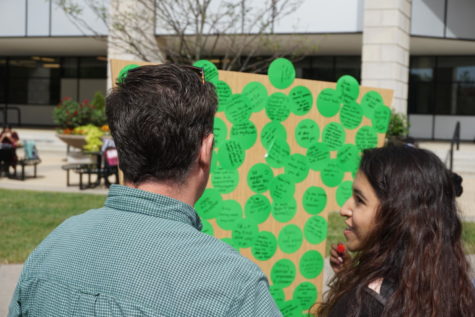Tips for surviving freshman year in the College of Design
May 31, 2011
First off, congratulations, pre-design majors. You have chosen a school with an endless list of accolades at which to pursue your degree.
Iowa State’s College of Design is renowned nationwide for churning out talented artists, architects and designers year after year. This could not happen without your hard work and dedication to the program.
You may know all about the Core Design Program from your summer orientation, or you may only have a vague idea of the classes you’ll be taking over the next two semesters.
Either way, let me break it down for you: In addition to an art history and theory course, you will have two 4-credit studio classes; that’s one more credit than the typical college course. That one extra credit means more than you might think. It signifies the extra thought, time and effort that must go into each of your projects during your time in these studios.
Sound a little intimidating? If you answered yes, I completely understand where you’re coming from. Three years ago, I stood exactly where each of you are right now, not fully knowing what I wanted to pursue at the College of Design beyond my love of art.
Over the course of the year I had nothing but positive experiences in studio. Despite this, I remember thinking that there were things I wish I’d have known coming into the design program at the beginning of my freshman year.
That’s where this article comes in handy for you, pre-design majors. Here are five tips, taken from my own experiences paired with the advice of faculty, guaranteed to keep you on top of things during your first year of studies at Iowa State.
Time management is key: In college, you will typically get just as much out of a class as you put into it. Regardless of your major or the class, this practically always bodes true.
This is particularly important to you as a design student. In fact, I listed it as No. 1 for a reason: It is nearly impossible to fake complete studio work. Whereas in other classes you might be able to bullshit a paper the night before it is due, this will never work for a drawing.
This does not mean that grueling late nights in studio are a necessary part of your education. As long as you set your priorities straight when it comes to studio work, you should have no trouble completing assignments before their respective deadlines.
Chuck Richards, associate professor in integrated studio arts, said a good guideline to keep in mind is that you typically should be spending about the same amount of time out of class working on studio projects as you are in class, if not more.
“Meeting the deadline with finished work is part of the objective,” Richards said, stressing the importance of always completing your projects.
This kind of planning ahead will help you avoid awkward situations in which, say, you’re halfway through a drawing around 10 p.m. when your instructor walks in and starts to dismantle the still-life before your eyes. This may or may not have happened to me.
Drawing is a learn-able skill: I realize that at times taking a drawing studio can be a little intimidating. When I entered the core program, I knew I was not a strong artist when it came to drawing. After a few less-than-stellar pieces, I thought my career was slowly going down the drain.
It wasn’t until after working with my instructor and learning to look at objects a little differently that those arrangements full of plastic oranges and wine bottles began to come alive in my drawings.
You may wonder why being able to draw accurately is important, especially if you plan on pursuing a more technical field within the College of Design. Drawing is emphasized so strongly in the first year because one of its main objectives is to train the students to think like designers.
“It’s all about trying to open up new ways of seeing the world around you,” said Ann Sobiech-Munson, core program director and assistant professor in architecture.
Being able to take something visual and convey it graphically is a big component of this mindset. You will probably get discouraged at times. With practice, which Dsn S 131 will provide you with plenty of, you’ll see improvement in no time.
Consider this: you are already visually inclined and eager to learn. What better formula is there for success in a drawing class?
Keep an open mind about next year: My main goal when I arrived on campus in the fall of 2008 was to leave Iowa State in five years with a degree in architecture. As I moved through Dsn S 102 and 131, I realized that the clean lines and fine precision of architecture weren’t for me.
Conversely, I liked to become a bit more down and dirty with my work. In other words, I was the girl that would leave drawing studio covered in charcoal, dodging stares on the walk back to my dorm.
Having an open mind and not zoning in on the fact I had come to Iowa State specifically to be an architect definitely helped to open my eyes to the other opportunities that the College of Design had to offer.
I ended up realizing I’d be much more suited to working in integrated studio arts after getting to know each of the programs a little more in depth.
Each project you complete in studio is specifically designed to help you think as a designer in a general sense, not as an interior designer or landscape architect. The experiences you will have over the course of the next year in studio will likely change the preconceived notions you have about careers in design and help you to formulate a better idea of what you’d like to do upon graduating.
“Part of why you’re here is to figure out what you want to do. It requires effort and work, and there’s a certain trial and error to it all,” Richards said. “You really shouldn’t be stressed about selecting a career path when you’re 18 because it can always change.”
All in all, it’s great to have a program in mind at the beginning of your first year, just make sure you give the others a fair chance.
Don’t take critiques personally: Critiques are a fact of life in the design disciplines. While they can follow a multitude of formats, all critiques serve the same basic purpose: to provide you with feedback about how to improve and revise your work from peers, instructors and, occasionally, industry professionals.
To be honest, I almost cried during my first critique. It may have just been the perfectionist in me, but something about my peers pointing out the flaws in my work just rubbed me the wrong way.
Once I realized that critiques serve a completely constructive purpose and that the students in your class are not out to get you, but simply to help you, critiques became something I looked forward to.
There is no better resource for constructive criticism and positive reinforcement than those working around you within the same constraints.
“You have the rare opportunity to take real advantage of learning from other students,” Richards said. “Students typically learn best by example. Pay attention to [other students’ work in] the hallway.”
Learning to not take the critique process too personally will not only give you a lot more peace of mind, but will be advantageous to the quality of your work as well.
Your instructors and fellow students are invaluable resources: While entering a program where you know no one at first may seem intimidating, I encourage you to use the situation to your advantage.
Get to know the students in your studio early on in the semester. Don’t feel like you need an excuse to talk to them, chat about your latest project, the other classes you’re taking and your plans for Friday night.
Getting to know the other students in your studio will not only ensure you have someone to call if you lose the syllabus or are sick during lecture, it’ll give you someone to go to when you need a advice on a project or to spend a late night working in studio with. Not to mention, being able to socialize will make the six hours you spend in studio a week a lot more fun.
Getting to know your instructors isn’t as simple as making smalltalk the first day, but is still completely doable. One of the best ways to do so is make sure you ask your instructor any questions that may arise during your projects.
“If you don’t know something, ask. If you don’t understand something, ask,” Sobiech-Munson said. “It’s as simple as just asking your instructor if you need anything clarified.”
If you’re having trouble with a drawing or brainstorming with project concepts, bring it to your instructor’s attention. These may seem like obvious things to do, but you’d be surprised by the number of students who simply make assumptions or are too embarrassed by a question to ask.
“Learn to have these kinds of discussions with your instructor about issues that come up early on,” Richards said. “Your success in this respect is really up to you.”
Maintaining a good dialogue with your instructor about how you’re doing in the class will not only provide you with more comprehensive feedback, but will also make it a bit easier to explain what happened when your roommate steps on your space container. Not that this ever happens, of course.
Enjoy your freshman year: This was supposed to be a top 5 list, but I really couldn’t end without encouraging you to make the most of your first year here because I guarantee you it will absolutely fly by.
Whether you went to a tiny high school in a small town or one with nearly 2,000 students, Iowa State provides more opportunities to actively engage yourself in your education than any secondary school.
Do your best to make time for things outside of design, leave yourself plenty of room to breathe and, most of all, have fun with your classes. After all, “if you’re not having fun now, it doesn’t bode well for the rest of your career,” Sobiech-Muson said.
















